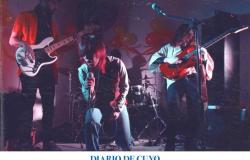A research group from IDEAus-CONICET found the oldest human remains in Patagonia and between the oldest in Argentina. Is about two individuals dated respectively to 9200 and 9700 radiocarbon years before the present (AP), which is equivalent to an age of between 10,400 and 11,000 calendar years.
The discovery took place in the coastal town of Camarones, located south of the province of Chubut.
The research was carried out by a team made up of scientists Julieta Gómez Otero, Ariadna Svoboda, Anahí Banegas and Gabriela Millánall of them from the Institute of Diversity and Southern Evolution (IDEAus, CONICET), which operates under the orbit of the CONICET-CENPAT of Puerto Madryn. The study was funded by CONICET and a grant from the Society for American Archeology, intended for pre-Columbian archaeological research.
He announcement took place on Friday, April 19 in the Auditorium of the Perón Family Museum of Shrimps, within the framework of the Indigenous Peoples’ Week. The authors of the work participated in the event, along with the mayor of Camarones, Claudia Loyola; the representative of the Ceferino Namuncurá native community Valentín Sayhueque, Rubén Romero Sayhueque; the Secretary of the Government of Camarones, Mario Arriagada; the person in charge of Culture, Horacio Yancafil; the mayor of the Patagonia Austral Coastal Interjurisdictional Marine Park (PIMCPA), Juan Duro and the vice director of the CONICET-CENPAT CCT, Pablo Bouza.
The remains were found in October 2020 by a group of bricklayers, while they were carrying out excavations for the installation of gas in a house under construction. Faced with this situation, the owners of the land filed a complaint at the local police station, from where they notified the authorities of the Undersecretariat of Culture of Chubut, who, in turn, summoned the IDEAus professionals and the representative of the Provincial Directorate. of Indigenous Affairs. This was done in accordance with the provisions of the provincial law for the protection of archaeological, anthropological and paleontological heritage (Law XI/11) and the Protocol for the treatment of archaeological human remains (Law V/160).
Once the investigation team was notified, the burial sector was preserved until the beginning of the archaeological work, which consisted of cleaning the area, partial excavation of the human remains, taking three-dimensional images and photographs, identification and characterization of the associated cultural materials and the description of the sedimentological substrate. In a subsequent campaign, a laboratory was set up in situ for preliminary bioanthropological analyzes in order to determine the minimum number of individuals and the probable age of each one. In March 2022, the rescue of the remains was authorized and their transfer to the IDEAus Archeology and Biological Anthropology laboratory.
The bioanthropological study identified the presence of a boy or girl between 8 and 9.5 years old and an adolescent between 12 and 15 years old; In no case was it possible to estimate sex. Some time later, direct radiocarbon dating by AMS was sent to two laboratories in the United States: first at the University of Arizona and later at the Institute of Energy and the Environment in Pennsylvania. The results were surprising: the age of both ranges between 9,200 and 9,700 radiocarbon years BP, which are equivalent to 10,400 and 11,000 calendar years, respectively. This chronological difference between one and the other indicates that they were not contemporaries.
“When we received the first dates we thought they were erroneous, that the samples studied could be aged due to contamination with organic components of the sediments. So, on the recommendation of INCUAPA colleagues. CONICET-UNCPBA, protein quality studies and new dating were carried out, which confirmed the initial ages,” says archaeologist Ariadna Svoboda.
In addition, associated with the youngest child, 50 bird bone beads were found, probably from a cormorant, and also abundant red pigment, which indicates mortuary practices from very ancient times. “Knowing that this practice is almost eleven thousand years old is also important information, since both the beads and the ocher were considered part of a late funerary custom in the area and this discovery shows that they are much older,” says Banegas.
Millán, in turn, points out that during the analysis of the remains there was no evidence of disease, malnutrition or violence. Finally, stable isotope studies of Carbon 13 and Nitrogen 15 indicated that both individuals would have had a mixed diet, which combined foods from land and sea, suggesting an early interaction with the Atlantic coastal space.
The paleocoastal models, made by specialists from the Patagonian Institute of Geology and Paleontology (IPGP-CONICET) of CENPAT, show that 11 thousand years ago, the sea was nine kilometers from the current coast, so the landscape was different from From now. “It is the first dating of such an ancient human occupation on the Atlantic coast, since until now the earliest sites were recorded in the interior or on the Pacific slope,” highlighted Gómez Otero.
The researchers highlight that, prior to the scientific publication of the finding in a scientific journal, they prioritized sharing these results with the authorities enforcing heritage laws, the community of Camarones and the indigenous peoples.
Group history
The Atlantic Coast Archeology Group of the province of Chubut began in 1990 under the direction of Julieta Gómez Otero. Initially, research was concentrated in Camarones and since 1993 on the northern coast of the province of Chubut. In these 34 years, researchers, scholarship holders and undergraduate and postgraduate thesis students participated, including archaeologists, bioanthropologists, geologists and marine biologists. In an interdisciplinary manner, aspects related to paleoenvironments, use of space and mobility, lithic and ceramic technology, food (zooarchaeology and stable isotope studies), use of plant resources (archaeobotany), funerary practices, symbolic expressions and historical shipwrecks are investigated.
The results were reflected in numerous works in national and international magazines, book chapters, presentations at Argentine and foreign conferences, popular articles and community outreach activities. As a corollary of the research, the Archaeological and Bioanthropological Repository of the IDEAus-Secretaría de Cultura del Chubut was formed, highlighted nationally for the abundance and richness of materials and the contextual information derived from field and laboratory work. Another aspect to highlight is the participation in rescues and restitution of archaeological human remains in conjunction with communities originating from Chubut.
This materialized in the signing of the “Protocol for the Treatment of Human Bone Remains” (LAW VN° 160) in the Chubut legislature. Due to all these backgrounds, the group is considered a reference regarding provincial cultural heritage and is frequently consulted by governmental and non-governmental organizations.






